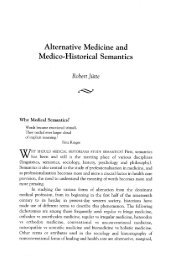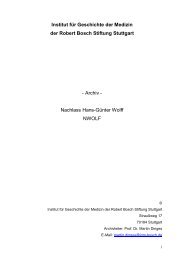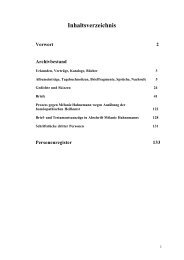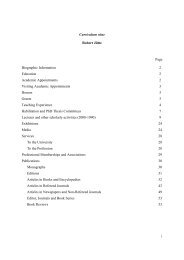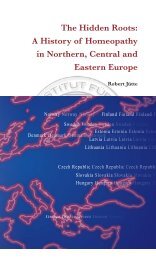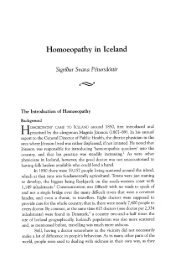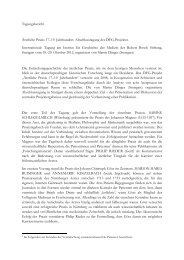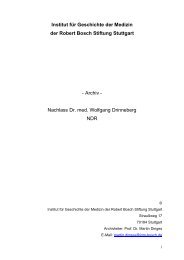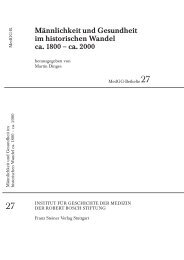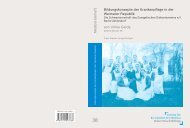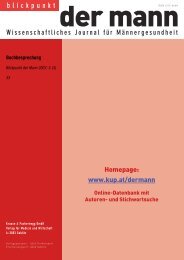pathy Homoeopathy – A Medical Approach and Its History
pathy Homoeopathy – A Medical Approach and Its History
pathy Homoeopathy – A Medical Approach and Its History
You also want an ePaper? Increase the reach of your titles
YUMPU automatically turns print PDFs into web optimized ePapers that Google loves.
Homoeo<strong>pathy</strong><br />
Homoeo<strong>pathy</strong> <strong>–</strong><br />
A <strong>Medical</strong> <strong>Approach</strong> <strong>and</strong><br />
<strong>Its</strong> <strong>History</strong><br />
An exhibition by the Institute<br />
for the <strong>History</strong> of Medicine<br />
of the Robert Bosch Foundation<br />
Stuttgart, Germany
© Institute for the <strong>History</strong> of Medicine<br />
of the Robert Bosch Foundation<br />
Stuttgart, Germany<br />
Scientific direction:<br />
Prof. Dr. Martin Dinges<br />
Prof. Dr. Robert Jütte<br />
Typesetting <strong>and</strong> layout:<br />
Braun Engels Gestaltung,<br />
Ulm, Germany<br />
Homoeo<strong>pathy</strong> <strong>–</strong><br />
A <strong>Medical</strong> <strong>Approach</strong> <strong>and</strong><br />
<strong>Its</strong> <strong>History</strong><br />
An exhibition by the Institute<br />
for the <strong>History</strong> of Medicine<br />
of the Robert Bosch Foundation<br />
Stuttgart, Germany
Contents<br />
What is Homoeo<strong>pathy</strong>? 4<br />
The Old School<br />
of Medicine 9<br />
Samuel Hahnemann<br />
<strong>and</strong> the Beginnings<br />
of Homoeo<strong>pathy</strong> 12<br />
Dissemination<br />
<strong>and</strong> Development 20<br />
Homoeo<strong>pathy</strong><br />
Worldwide 30<br />
Homoeo<strong>pathy</strong><br />
Today 44
What is Homoeo<strong>pathy</strong>?<br />
4 | 5<br />
Homoeo<strong>pathy</strong> (from the Greek words homoios =<br />
similar <strong>and</strong> pathos = suffering) is an independent<br />
experience-based method of treatment. It was<br />
developed in the 1790s by the physician Samuel<br />
Hahnemann (1755<strong>–</strong>1843) from Saxony in Germany.<br />
Homoeo<strong>pathy</strong> does not identify diseases as such,<br />
but sees disease as a disorder that affects the whole<br />
human being. Fever, pain etc are merely symptoms<br />
of this general dis or der. Unlike orthodox medicine,<br />
homoeo<strong>pathy</strong> does there fore not focus on a par ticular<br />
disease but on the whole person.<br />
A person is considered healthy as long as his or her<br />
organ ism is able to counterbalance any intruding<br />
pathogenic agents. Homoeopathic treatment aims<br />
at re-establishing the lost balance by using ap propriate<br />
remedies.<br />
<strong>–</strong><br />
<strong>–</strong><br />
<strong>–</strong><br />
‘Classical homoeo<strong>pathy</strong>’, as founded by Hahnemann,<br />
is based on three principles:<br />
01<br />
The principle of similarity (‘Law of Similars’) which says<br />
that a disease is to be treated with the remedy that<br />
produces similar symptoms in healthy individuals.<br />
Drug proving on the healthy person to establish which<br />
symptoms a remedy can produce.<br />
The drawing up of an individual disease picture based<br />
on thorough case taking (anamnesis).
01 WHAT IS HOMOeOPATHy?<br />
[1] Questionnaire for homoeopathic case taking,<br />
by Hugo Ohntrup MD (1914<strong>–</strong>1996)<br />
© Deutsches Hygienemuseum, Dresden<br />
The Patient’s <strong>History</strong> <strong>–</strong> Where Treatment Begins<br />
The Simile Principle<br />
6 | 7<br />
[2] Samuel Hahnemann,<br />
Repertories. Unpublished<br />
manuscripts, Leipzig, c. 1817<br />
© Brigitta Ahlborn, IGM<br />
As there is no disease as such in homoeo<strong>pathy</strong> but<br />
only the ‘diseased person’, the treatment begins with<br />
indepth case taking. It is of partic ular interest how<br />
the patient describes his characteristic complaints <strong>and</strong><br />
symptoms, former illnesses <strong>and</strong> his situation in life.<br />
A physical examination can complement the<br />
conversation [1].<br />
The patient’s overall symptom picture determines<br />
the choice of homoe opathic remedy. Repertories (lists<br />
of symptoms matched to particular remedies) <strong>and</strong><br />
comprehensive pharmacopoeias (detailed descriptions<br />
of the proving symptoms of individual reme dies) help<br />
to find the right medicine [2].<br />
The patient’s reactions to the remedy allow conclusions<br />
about the healing process <strong>and</strong> further treatment.<br />
The most important basis for homoeopathic treatment<br />
is the ‘Law of Similars’. According to the similarity<br />
principle, diseases can be cured with the substances<br />
that, in a healthy person, produce symptoms that<br />
correspond to those caused by the disease.<br />
[3] Spanish flies<br />
© IGM picture library<br />
Drug Proving<br />
[4] Triturating bowl with the first third of lactose<br />
<strong>and</strong> a good grain of thuja<br />
© Gudjons<br />
The homoeopath compares the symptoms, which were<br />
found to be characteristic for a substance in drug<br />
provings, to the symptoms displayed by the patient<br />
<strong>and</strong> chooses the remedy with the highest similarity.<br />
Apart from the patient’s history, the homoeopath<br />
needs to know the symptoms that the active agent<br />
of a remedy produces in a healthy person, that is<br />
to say the drug disease, in order to be able to apply<br />
the similarity principle.<br />
Each remedy is described by its ‘drug picture’ which<br />
is based on the proving results <strong>and</strong> knowledge of its<br />
typical effect on the sick person.<br />
For a drug proving a group of healthy test subjects<br />
are given a potentized homoeopathic remedy for a<br />
specified period of time. Only the person conducting<br />
the test knows which remedy it is. All symptoms observed<br />
during this period of time are registered on a<br />
daily basis. Place, time <strong>and</strong> any changes experienced<br />
by the test subjects are faithfully recorded [3] [5] [6].
01 WHAT IS HOMOeOPATHy?<br />
[5] Eupatorium perfolatum<br />
© IGM picture library<br />
Potentization<br />
8 | 9<br />
[6] Silicea<br />
© Bruno Vonarberg, Brülisau<br />
Homoeopathic remedies are specially prepared<br />
in compliance with the official Homoeopathic<br />
Pharma copoeia (HAB).<br />
To start with, the plant, animal or mineral raw material<br />
is liquidized (mother tincture) or pulverized (trituration).<br />
In the potentization process these substances are then<br />
mixed, step by step, by succussion or trit ura tion:<br />
mother tinctures usually with ethanol, triturations with<br />
lac tose. Certain dilution ratios have to be maintained:<br />
1:10 = D1 potency; 1:100 = C potency;<br />
1:50,000 = Q or LM potency.<br />
For the preparation of a D2 potency one part of the<br />
first D1 potency is again mixed with 9 parts ethanol.<br />
The process is repeated until the desired potency<br />
has been obtained. One differentiates between low<br />
potencies (D1/C1 to D12/C6), medium potencies<br />
(D12/C6 to D30/C15) <strong>and</strong> high potencies (from D30/<br />
C15 up to 1000).<br />
Homoeopathic remedies are usually prescribed in<br />
form of dilutions (drops), pilules or tablets [4].<br />
The Old School<br />
of Medicine<br />
02<br />
Very little was known about the human body in the<br />
18th century. Although William Harvey (1578<strong>–</strong>1657)<br />
had correctly described the circulation of the blood,<br />
metabolism, bacteria <strong>and</strong> hormones were not yet<br />
known.<br />
Based on the doctrine of the four humours, illness<br />
was seen as a sign that blood, phlegm <strong>and</strong> black <strong>and</strong><br />
yellow bile were no longer in balance. One sought to<br />
re-establish the balance by employing blood-letting,<br />
laxatives <strong>and</strong> emetics.<br />
<strong>Medical</strong> treatment was mostly based on theoretical<br />
models. Often drug mixtures were prescribed <strong>and</strong><br />
high doses of poisonous substances such as arsenic<br />
<strong>and</strong> mercury. In con trast, Hahnemann’s strongly<br />
diluted <strong>and</strong> exactly measured doses made homoeo<strong>pathy</strong><br />
look much more attractive.
02 THe OLD SCHOOL OF MeDICIne<br />
The Four-Humour-Theory<br />
10 | 11<br />
[8] Bloodletting scene, from: Wolfgang H. von<br />
Hohberg: Calender. Das L<strong>and</strong> und Feldleben<br />
Adeliger [Calendar. Country life of the nobility],<br />
Nuremberg 1682<br />
© IGM picture library<br />
[7] Hippocrates, engraving by André J. Mécou<br />
after Vauthier, no date<br />
© Wellcome Library, London<br />
From antiquity up to modern times, medical treatment<br />
was based on the fourhumourtheory. The doctrine<br />
which was also known as humoral pathology goes back<br />
to the Greek physician Hippocrates (c. 460<strong>–</strong>370 BC).<br />
He defined disease as an imbalance of the body<br />
humours or fluids (blood, phlegm, black <strong>and</strong> yellow<br />
bile) which could also be caused by adverse air,<br />
water or earth conditions [7].<br />
Emptying the body was thus for decades the main<br />
ambition. Patients had to undergo debilitating pro cedures<br />
involving bloodletting, enemas <strong>and</strong> emetics.<br />
The cellular pathology of Rudolf Virchow (1821<strong>–</strong>1902),<br />
which reduced the development of disease to intracellular<br />
changes, replaced the fourhumourtheory in<br />
the end.<br />
Health Care: Physicians, Barber-Surgeons, Lay Healers<br />
In the 18th century health care was not provided by the<br />
same pro fessional groups as today. Only a small mi nority<br />
of practitioners had studied medicine, the majority<br />
were barbers <strong>and</strong> surgeons. The barbers used mostly<br />
bleeding <strong>and</strong> cupping while the surgeons carried out<br />
surgery <strong>and</strong> also amputations. Both professions were<br />
seen as trades which one learned from a master.<br />
Many lay healers also knew about the healing<br />
power of plants <strong>and</strong> other substances <strong>and</strong> applied<br />
their medical knowledge at all levels of society.<br />
Up to the 18th century miracle healers, teethpullers<br />
<strong>and</strong> sellers of spectacles offered their wares <strong>and</strong><br />
services on markets <strong>and</strong> fairs [8].<br />
<strong>Medical</strong> Training in the 18th Century<br />
[9] Female anatomy<br />
model made from ivory,<br />
c. 1700<br />
© Medizinhistorisches<br />
Museum, Zurich<br />
[10] Josephinum. State academy for<br />
medicine <strong>and</strong> surgery in Vienna, coloured<br />
copperpanel engrav ing by Karl Schütz,<br />
late 18th century. The Josephinum was<br />
one of the first academies that provided<br />
scientific training for surgeons<br />
© Medizinische Universität Vienna<br />
For centuries the universities taught all medical<br />
knowledge from books. Anatomical studies were<br />
carried out on dummies, foldouts or wax models.<br />
Dissections of corpses were very rare. Knowledge<br />
of the human body was quite limited <strong>and</strong> bedside<br />
teaching only happened in exceptional cases [9].<br />
In the 18th century a reformation of the medical<br />
training set in at some universities. Theoretical<br />
knowledge was to be verified <strong>and</strong> complement ed<br />
by prac tical bedside teaching. One of the re form<br />
ers was Joseph von Quarin (1733<strong>–</strong>1814), Samuel<br />
Hahnemann’s teacher in Vienna. Hahnemann said<br />
later about his studies in Vienna that it was due<br />
to Quarin that he had become the physician he<br />
was [10].
03<br />
Samuel Hahnemann<br />
<strong>and</strong> the Beginnings<br />
of Homoeo<strong>pathy</strong><br />
12 | 13<br />
As a young physician Samuel Hahnemann experienced<br />
again <strong>and</strong> again how little he could achieve with the<br />
theoretical knowledge he had acquired. Disappointed,<br />
he withdrew from medical practice <strong>and</strong>, over the follow<br />
ing years, made a name for himself as a translator<br />
<strong>and</strong> medical author.<br />
When translating William Cullen’s Materia Medica in<br />
1790 he came across the Simile Principle which he<br />
publicized for the first time in 1796, in the Journal der<br />
practischen Arzneykunde (Journal of practical medicine).<br />
In the ‘Rule of Similars’ Hahnemann thought to<br />
have discovered the foundation for the effective treatment<br />
method which he had been trying to find for<br />
many years.<br />
In the decades that followed he meticulously in ves tigat<br />
ed the effect of medicinal substances. He pub lished<br />
the out-come of his observations in his Organon<br />
der rationellen Heilkunde (Organon of the Healing<br />
Art) in 1810, which, up to the present time, has<br />
remained every homoeopath’s mainstay.<br />
During the great European cholera epidemic (1830<strong>–</strong><br />
1832) homoeopathic treatment saved more lives than<br />
any other method. This overwhelming success won<br />
many people over to the new approach to healing.<br />
[11] Samuel Hahnemann<br />
(1755<strong>–</strong>1843) by Mélanie<br />
Hahnemann, 1835<br />
© IGM picture library<br />
Samuel Hahnemann: Life <strong>and</strong> Work [11]<br />
[12] Samuel Hahnemann, Organon<br />
der rationellen Heilkunde, first<br />
edition, Dresden 1810, title page<br />
© IGM picture library<br />
1755 born 10th April in Meißen/Germany the son of<br />
porcelain painter Christian Gottfried Hahnemann <strong>and</strong><br />
his wife Johanna Christiane née Spieß<br />
1775<strong>–</strong>1777 medical studies in Leipzig<br />
1777 further studies in Vienna <strong>and</strong><br />
first work experience<br />
1779 doctorate in Erlangen/Germany<br />
1780 first practice in Hettstedt near Halle/Saale<br />
1782 marriage to Henriette Küchler in Dessau<br />
1783 <strong>–</strong> 1785 public health officer in Gommern<br />
(near Magdeburg)<br />
1785 <strong>–</strong> 1789 relocation to Dresden <strong>and</strong> opening of<br />
practice; work as coroner <strong>and</strong> registrar in Dresden<br />
municipal hospitals; growing dissatisfaction with orthodox<br />
medicine <strong>and</strong> temporary withdrawal from practice;<br />
translation of French <strong>and</strong> English medical <strong>and</strong> pharmaceutical<br />
writings; own scientific publications<br />
1789 <strong>–</strong>1790 relocation to Leipzig, then to Stötteritz<br />
near Leipzig; continuation of scientific research; translation<br />
of the Scottish physician William Cullen’s Materia<br />
Medica <strong>and</strong> selfexperiments with cinchona bark
03 SAMueL HAHneMAnn AnD<br />
THe BegInnIngS OF HOMOeOPATHy<br />
14 | 15<br />
1792 relocation to Gotha, then Georgenthal;<br />
treatment of the insane F. A. Klockenbring,<br />
Secretary to the Chancellery of Hanover<br />
1793 <strong>–</strong> 1796 residence in the German towns of<br />
Molschleben, Göttingen, Pyrmont, Wolfenbüttel,<br />
Braunschweig<br />
1796 Hahnemann phrases the central idea of the<br />
homoeopathic doctrine: similia similibus curentur<br />
(let like be cured by like)<br />
1796 <strong>–</strong> 1805 residence in Königslutter, Altona,<br />
Hamburg, Mölln, Machern, Eilenburg, Schildau<br />
1805 <strong>–</strong> 1811 medical practice in Torgau<br />
1807 Hahnemann for the first time calls his approach<br />
to healing ‘homoeo<strong>pathy</strong>’<br />
1810 publication Organon der rationellen Heilkunde<br />
(Organon of the Healing Art) [12]<br />
1811 <strong>–</strong> 1821 removal to Leipzig; habilitation <strong>and</strong><br />
teaching [16]; formation of a union of drug provers<br />
with his students<br />
1820 the Leipzig apothecaries sue Hahnemann for<br />
dispensing his own medicines [15]; Prince Karl Philipp<br />
of Schwarzenberg seeks homoeopathic treatment<br />
from Hahnemann<br />
[13] Samuel Hahnemann’s pocket<br />
pharmacy in book form, c. 1830<br />
© IGM picture library<br />
1821 relocation to Coethen; opening of a practice<br />
with the right to dispense his own medicines [13]<br />
1822 Hahnemann’s appointment as court counsellor<br />
by Duke Ferdin<strong>and</strong> of Coethen<br />
1829 50th anniversary of Hahnemann’s doctorate;<br />
foundation of the Verein zur Beförderung und Ausbildung<br />
der homöopathischen Heilkunst (Society for<br />
the promotion <strong>and</strong> development of homoeo pathic<br />
medicine); money collection for the homoeopathic<br />
hospital in Leipzig<br />
1830 Henriette Hahnemann dies<br />
[14] Samuel Hahnemann’s stethoscope<br />
from his Paris practice, c. 1840<br />
© IGM picture library<br />
[15] Samuel Hahnemann’s first<br />
medicine chest<br />
© IGM picture library<br />
[16] Announcement of a lecture<br />
by Samuel Hahnemann<br />
at Leipzig University, c. 1815<br />
© IGM picture library<br />
1835 Hahnemann marries the French painter Mélanie<br />
d’HervillyGohier who is 45 years his junior; relocation<br />
to Paris <strong>and</strong> opening of joint homoeopathic practice<br />
which becomes famous all over Europe [14]<br />
1843 Hahnemann dies <strong>and</strong> is buried in the cemetery<br />
of Montmartre
03 SAMueL HAHneMAnn AnD<br />
THe BegInnIngS OF HOMOeOPATHy<br />
[17] Description of the brooches of the<br />
German Central Association of Homoeopathic<br />
Physicians, 1964<br />
© IGM picture library<br />
The Central Association of Homoeopathic Physicians<br />
16 | 17<br />
[18] Leipzig Homoeopathic Hospital<br />
(1888<strong>–</strong>1901), from: Allgemeine Homöo pathische<br />
Zeitung 116 (1888), No. 23, p. 177<br />
© IGM picture library<br />
In 1829, on the occasion of the 50th anniversary of<br />
Samuel Hahne mann’s doctorate, the Society for the<br />
promotion <strong>and</strong> development of homoeopathic medicine<br />
was founded in Coethen. From 1832 onwards,<br />
it was known as the Zentralverein homöopathischer<br />
Ärzte (Central Association of Homoeopathic Phy sicians).<br />
It had to face severe attacks, for example in<br />
connection with the high potencies, but is still in<br />
existence as the German Central Association of<br />
Homoeopathic Physicians [17].<br />
The journal Allgemeine Homöopathische Zeitung,<br />
founded in 1832 by Hahnemann’s pupil Friedrich<br />
Rummel, served as the association’s internal discussion<br />
forum. In 2007 it celebrated its 175th anniversary [21].<br />
In 1833 <strong>and</strong> 1888, the association founded a teaching<br />
<strong>and</strong> healing institute in Leipzig. Both times it had to<br />
be closed down again after a short time due to fi nancial<br />
difficulties <strong>and</strong> quarrelling among the physicians.<br />
From 1842 the association maintained a polyclinic in<br />
Leipzig which existed up to its destruction in the war<br />
in 1943 [18].<br />
[19] Cholera apothecary, France, c. 1840<br />
© Fonds documentaire Boiron, Lyon<br />
[20] Wilhelm Zipperlen, Der illustrirte Hausthierarzt<br />
[The illustrated domestic veterinarian],<br />
title page, Ulm 1894<br />
© Deutsches Hygienemuseum, Dresden<br />
Veterinary Homoeo<strong>pathy</strong><br />
Before the invention of motor vehicles <strong>and</strong> tractors<br />
animals played a much more important part in ag ri culture<br />
<strong>and</strong> transport than they do today. In 1815 the<br />
Coburg court apothecary Donauer published the first<br />
veterinary homoeopathic paper: Suggestions for the<br />
more appro priate treatment of sick dogs. In 1829<br />
Samuel Hahnemann spoke in front of farmers <strong>and</strong><br />
veterinarians about homoeo<strong>pathy</strong> in veterinary<br />
medicine postulating the exact observation of sick<br />
animals as well as careful investigation into <strong>and</strong><br />
thorough knowledge of medicines.<br />
In the 19th century, veterinarians were not everywhere<br />
permitted to treat animals homoeopathically because<br />
the method was still controversial. At the end of the<br />
century interest in animal homoeo<strong>pathy</strong> subsided <strong>and</strong><br />
was only rekindled in the 1920s. Today, dem<strong>and</strong> is on<br />
the increase again <strong>and</strong> homoeo<strong>pathy</strong> is used more<br />
frequently now in veterinary medicine [20].
03 SAMueL HAHneMAnn AnD<br />
THe BegInnIngS OF HOMOeOPATHy<br />
Famous Patients<br />
18 | 19<br />
[21] Allgemeine Homöopathische<br />
Zeitung 1<br />
[first gen eral homoeopathic<br />
journal] (1832/33), title page<br />
© IGM picture library<br />
[22] Field Marshal<br />
Karl Philipp Prince<br />
of Schwarzenberg<br />
(1771<strong>–</strong>1820), portrait<br />
by Natale Schiavoni,<br />
no date<br />
© Schwarzenbergische<br />
Archive, Murau/Austria<br />
After the Organon of the Healing Art was published in<br />
1810, public interest in homoeo<strong>pathy</strong> grew stronger.<br />
When field marshal Prince Schwarzenberg, victor of<br />
the Battle of Leipzig, became Hahnemann’s patient in<br />
1820, homoeo<strong>pathy</strong> was the topic talk of the day [22].<br />
Kaspar Hauser was also treated homoeopathically.<br />
His Ansbach physi cian Paul Preu corresponded with<br />
Hahnemann. Since Hahnemann’s times homoeopathic<br />
treatment of famous patients has fanned curiosity<br />
about the method [24].<br />
[23] Cholera, engraving by Honoré<br />
Daumier (1808 <strong>–</strong>1879), c. 1845<br />
© IGM picture library<br />
[24] Kaspar Hauser (1812<strong>–</strong>1833),<br />
unknown engraver, 1828<br />
© Das Gleimhaus, Halberstadt<br />
Cholera <strong>and</strong> the Successes of Homoeo<strong>pathy</strong><br />
At the beginning of 1817, cholera broke out in India<br />
<strong>and</strong> spread unrelentingly to Europe reaching Moscow<br />
in 1830 <strong>and</strong> Berlin in 1831.<br />
Some physicians, not knowing what else to do, decided<br />
to bleed the patients, who were very weak in any case.<br />
They treated them with high doses of mercury <strong>and</strong><br />
opium <strong>and</strong> forbade them to drink [23].<br />
Hahnemann did not treat any cholera patients himself<br />
as the area around Coethen was spared from the epidem<br />
ic. Soon after the outbreak of cholera he rec ommended,<br />
however, to treat it with camphor. He spoke<br />
against bloodletting <strong>and</strong> not allowing patients to<br />
drink. With this therapy many more patients survived<br />
than with the conven tion al method.<br />
Due to the successful homoeopathic treatment of<br />
cholera homoeo <strong>pathy</strong> fast gained popularity in many<br />
other places [19].
04<br />
Dissemination<br />
<strong>and</strong> Development<br />
20 | 21<br />
Several factors supported the spreading of homoeo<strong>pathy</strong><br />
during the second half of the 19th century.<br />
Wealthy <strong>and</strong> prominent benefactors contributed to<br />
increase public recognition of homoeo<strong>pathy</strong>. Their<br />
social st<strong>and</strong>ing drew the attention of wide parts of<br />
the population to it.<br />
Since around 1870 the tens of thous<strong>and</strong>s of members<br />
of lay societies accelerated the dissemination of<br />
homoeo<strong>pathy</strong>, the German States of Württemberg<br />
<strong>and</strong> Saxony becoming the main centres.<br />
During the last quarter of the 19th century some<br />
homoeo pathic pharmacies began to produce their<br />
remedies on an industrial scale. By using modern<br />
advertising methods they gained more <strong>and</strong> more<br />
customers.<br />
In the mid-19th century some German universities<br />
offered lectures on homoeo<strong>pathy</strong>. But it was only in<br />
1928 that a teaching position for homoeo<strong>pathy</strong> was<br />
again assigned in Berlin.<br />
For a time, the National Socialists in Germany<br />
incorporated homoeo<strong>pathy</strong> as well as other nonorthodox<br />
healing methods into their health policy.<br />
Many homoeopaths hoped that this would bring<br />
them closer to the looked-for public recognition.<br />
[25] Julie Princess of<br />
OettingenWallerstein<br />
(1807<strong>–</strong>1883), lithograph<br />
by Ignaz Fertig, 1836<br />
© Jan Kunkel, Munich<br />
Benefactors <strong>–</strong> Patrons <strong>–</strong> Sponsors<br />
Homoeopathic Lay Societies<br />
[26] Robert Bosch Hospital,<br />
Stuttgart, c. 1940<br />
© Bosch Archiv, Stuttgart<br />
[27] Robert Bosch senior<br />
(1861<strong>–</strong>1942), 1936<br />
© Bosch Archiv, Stuttgart<br />
A number of wealthy <strong>and</strong> prominent personalities<br />
became generous supporters of homoeo<strong>pathy</strong> after<br />
they had undergone successful treatment.<br />
Julie Princess of OettingenWallerstein (1807<strong>–</strong>1883)<br />
had met homoeo<strong>pathy</strong> in Munich through her private<br />
physician. In 1883, her legacy helped finance the<br />
Homoeopathic Hospital in Munich (1883<strong>–</strong>1912) [25].<br />
Robert Bosch senior (1861<strong>–</strong>1942) had been treated<br />
homoeopathically as a child [27]. Having had to for<br />
sake his first project due to World War I he started a<br />
pro vi si on al hospital in 1921. In 1940 the newlybuilt<br />
Robert Bosch Hospital opened its doors. Up to the<br />
1960s most German homoeopathic physicians were<br />
trained there [26].<br />
Between 1870 <strong>and</strong> 1933 there were several hundred<br />
homoeopathic lay societies in Germany, at first mostly<br />
in the states of Württemberg <strong>and</strong> Saxony [30].<br />
These lay organisations promoted the distribution<br />
<strong>and</strong> sales of rem edies for selfmedication <strong>and</strong> invited<br />
homoeo pathic physicians to settle in their area. They<br />
also advocated the appointment of homoeo pathic<br />
chairs at universities <strong>and</strong> the foundation of homoeopathic<br />
hospitals. In lecture evenings they informed<br />
their members about the homoeopath ic approach
04 DISSeMInATIOn AnD DeVeLOPMenT<br />
[28] Advertisement for the<br />
training of nonmedical practitioners,<br />
from: Homöopathische<br />
Monatsblätter 62 (1937), No. 5,<br />
p. B 42<br />
© IGM picture library<br />
22 | 23<br />
[29] Tableau of the association course of the<br />
Heidenheim Homoeopathic Society celebrating<br />
its 40th anniversary in the Heidenheim<br />
concert hall, 1926<br />
© IGM picture library<br />
to healing. Because these societies were among the<br />
most important buyers of their products the pharmaceutical<br />
manufacturers supported their educational<br />
endeavours [29].<br />
In 1933, the homoeopathic societies agreed to their<br />
alignment (Gleichschaltung) by the Nazis. Most of them<br />
ceased their activities during World War II. After the<br />
war several attempts at bringing the societies back to<br />
life in the German Democratic Republic failed. In the<br />
German Federal Republic the homoeopathic lay societies<br />
did at first not reach the same membership numbers<br />
as before the war, but their popularity has been<br />
growing again since the 1980s.<br />
Homoeopathic Lay Healers <strong>and</strong> non-<strong>Medical</strong> Practitioners<br />
During Hahnemann’s lifetime many lay healers<br />
practised homoeo<strong>pathy</strong>, including his second wife<br />
Mélanie Hahnemann <strong>and</strong> his pupil Clemens von<br />
Bönninghausen.<br />
Baron Dr Clemens von Bönninghausen (1785<strong>–</strong>1864)<br />
was a lawyer <strong>and</strong> botanist [31]. After having been cured<br />
homoeopathically of pulmonary tuberculosis he became<br />
Hahnemann’s pupil. Because of his successes<br />
as a lay healer he was granted permission to practise<br />
in Prussia in 1843 without having studied medicine.<br />
His most famous patient was the poet Annette von<br />
DrosteHülshoff.<br />
[30] Small flag of the<br />
Röhrsdorf association<br />
on its 25th anniversary<br />
in 1938<br />
© Deutsches Hygienemuseum,<br />
Dresden<br />
[31] Clemens von Bönninghausen<br />
(1785<strong>–</strong>1864), portrait<br />
by Julius Roeting, c. 1894 (?)<br />
© IGM picture library<br />
[32] Mélanie Hahnemann<br />
(1800<strong>–</strong>1878),<br />
unknown engraver<br />
© IGM picture library<br />
Mélanie d’HervillyGohier (1800<strong>–</strong>1878) came to<br />
Coethen as Samuel Hahnemann’s patient <strong>and</strong> became<br />
his wife in 1835 [32]. After moving to Paris together<br />
they set up a practice which became highly renowned.<br />
From 1857, Mélanie Hahnemann practised together<br />
with her soninlaw, the physician Carl von<br />
Bönninghausen.<br />
Arthur Lutze (1813<strong>–</strong>1870) arrived in Coethen in 1850<br />
after an unsettled life as a post office clerk <strong>and</strong><br />
homoeo pathic lay healer. The Lutze Clinic which he<br />
founded continued to exist under various directors<br />
until around 1915.<br />
The German lay practitioners’ law of 1939 gave the<br />
lay healers the recognition they had long waited for,<br />
but this professional group did not grow considerably<br />
after 1945. Only in recent years, with the growing<br />
distrust in apparatus medicine, their number has been<br />
rising again [28].
04 DISSeMInATIOn AnD DeVeLOPMenT<br />
[33] Twostory pharmacy of<br />
Privy Councillor Virgil Mayer,<br />
Cannstatt, before 1915<br />
© IGM picture library<br />
24 | 25<br />
[34] Tincture room in<br />
Virgil Mayer’s pharmacy,<br />
Cannstatt, no date<br />
© IGM picture library<br />
From Workshop to World enterprise<br />
Almost everywhere in Germany physicians were for bidden<br />
to dispense drugs directly to their patients. Yet,<br />
the conventionally manufactured medicines often did<br />
not fulfil the requirements of the homoeopaths. From<br />
the 1830s homoeopathic pharmacies were founded<br />
which strictly adhered to Samuel Hahnemann’s in structions.<br />
These manually working enterprises were soon<br />
no longer able to meet the growing dem<strong>and</strong>. From<br />
the end of the 19th century some of them began to<br />
pro duce on an industrial scale [33] [34] [37].<br />
In 1866, the apothecary Willmar Schwabe (1839<strong>–</strong>1917)<br />
founded the pharmaceutical company Homöopathische<br />
Centralofficin Dr Willmar Schwabe in Leipzig. It grew<br />
quickly <strong>and</strong> opened branches worldwide. Also in 1866,<br />
he founded his own publishing business <strong>and</strong> published<br />
200 scientific <strong>and</strong> popular books on homoeo<strong>pathy</strong>. His<br />
Pharmacopoea homoeopathica (1872) still provided the<br />
basis for the official German Homoeopathic Pharmacopo<br />
eia of 1978 [36].<br />
Together with his brothers Hans <strong>and</strong> Friedemund, the<br />
pharmacist Dr Gerhard Madaus founded a pharma <br />
ceutical laboratory in 1919 which later relocated to<br />
Radebeul in Saxony [35].<br />
Using sophisticated advertising, publishing activities<br />
<strong>and</strong> the orga ni sation of further training courses for<br />
homoeopathic physicians, nonmedical <strong>and</strong> lay prac tition<br />
ers, these companies opened up an ever growing<br />
market.<br />
[35] Year Book 1931 Dr Madaus & Co.,<br />
Radebeul, title page<br />
© Deutsches Hygienemuseum, Dresden<br />
Health Insurance Companies<br />
[36] Trituration machines of the Willmar<br />
Schwabe Company, Leipzig, c. 1926<br />
© 60 Jahre im Dienst der Homöopathie<br />
1866<strong>–</strong>1926 [60 years in the service of<br />
homoeo <strong>pathy</strong> 1866<strong>–</strong>1926], ed. Willmar<br />
Schwabe, Leipzig 1926, p. 31<br />
In 1883, earlier than in other European countries, stat utory<br />
health in sur ance was established in Germany. Soon<br />
controversy broke out re gard ing the recognition of<br />
naturopathic <strong>and</strong> homoeopathic treatments by the<br />
health insurance companies. Almost all health insurers<br />
showed themselves very reluctant to accept homoeo<strong>pathy</strong><br />
in particular.<br />
Saxony was the only state where the health insurance<br />
providers ac cept ed the homoeopaths <strong>and</strong> agreed<br />
to pay for homoeopathic treatment. The local statu <br />
tory health insurer in Leipzig also maintained seven<br />
beds in the homoeopathic hospital. In 1910 its board<br />
of direc tors strongly lobbied for the promotion<br />
of homoeo <strong>pathy</strong>. <strong>Its</strong> president at the time was Dr<br />
Willmar Schwabe [38].<br />
The costs of homoeopathic treatment, which is listed<br />
in the German Medicines Act as a special therapeutic<br />
approach, have been accepted by more <strong>and</strong> more<br />
health insurance providers since the 1990s.
04 DISSeMInATIOn AnD DeVeLOPMenT<br />
Scientific ‘Border Crossers’<br />
26 | 27<br />
[38] Advertising badge of the local health<br />
insurance company Dresden, January 1914<br />
© AOK Dresden<br />
[37] Illustrated price list of the Homöopathische<br />
CentralApotheke Göppingen, c. 1910<br />
© Deutsches Hygienemuseum, Dresden<br />
Despite its rejection by orthodox medicine, there<br />
have always been conventional physicians <strong>and</strong><br />
scientists with a deeper <strong>and</strong> unprejudiced interest<br />
in homoeo <strong>pathy</strong>. Prominent among them were<br />
the pharma cologist Hugo Schulz (1853<strong>–</strong>1932) <strong>and</strong><br />
the surgeon August Bier (1861<strong>–</strong>1949) [42].<br />
After Hugo Schulz had studied the principles of<br />
homoeo <strong>pathy</strong> in detail <strong>and</strong> spoken about them<br />
favourably in public, his colleagues began to ostra<br />
cize him. August Bier sparked a heated debate<br />
when he asked in a paper published in 1925: What<br />
attitude should we have towards homoeo <strong>pathy</strong>?<br />
The contro versy did much to attract public attention<br />
to homoeo <strong>pathy</strong> in the 1920s <strong>and</strong> 30s.<br />
Homoeo<strong>pathy</strong> in World War I<br />
[40] Homoeopathic pocket pharmacy<br />
for the war, First World War<br />
© IGM picture library<br />
[39] Letters about homoeopathic treatment<br />
at the front, from: Homöopathische<br />
Monatsblätter 40 (1915), No. 1, p. 10<br />
© Deutsches Hygienemuseum, Dresden<br />
During the First World War many homoeopathic physicians<br />
were called upon to serve as medical staff in the<br />
army which meant that patients who were used to<br />
orthodox treatment became acquainted with homoeo<strong>pathy</strong>.<br />
The pharmaceutical manufacturers offered<br />
specially developed homoeopathic field pharmacies<br />
during the war years, which were also sold for selfmedication<br />
by the lay societies [39] [40].<br />
The Stuttgart Homoeopathic Hospital Association,<br />
supported by the lay society Hahnemannia in<br />
Württemberg, maintained a homoeopathic military<br />
hospital in Stuttgart from 1914 to 1919. Similar war<br />
hospitals existed also in other European countries.
04 DISSeMInATIOn AnD DeVeLOPMenT<br />
The Academic Chair Controversy<br />
28 | 29<br />
[41] Lecturers on the further training<br />
course for homoeopathic physicians in<br />
Stuttgart (September 1 to 11, 1926),<br />
from left: Ernst Bastanier, E. Epplée<br />
(Moscow), Heinrich Meng, Hermann<br />
Göhrum, Emil Schlegel, Alfons Stiegele,<br />
in the courtyard of the provisional<br />
hospital in Marienstraße, Stuttgart<br />
© IGM picture library<br />
[42] August Bier (1861<strong>–</strong>1949)<br />
at his departing lecture in Berlin<br />
1932<br />
© IGM picture library<br />
In the 19th century, applications to the parliaments of<br />
the German federal states of Baden, Saxony, Prussia<br />
<strong>and</strong> Württemberg to appoint homoeopathic chairs at<br />
the universities were rejected. Nevertheless it was<br />
possible up to the middle of the 19th century for<br />
individual lecturers <strong>and</strong> professors in Munich <strong>and</strong><br />
Leipzig to offer homoeo<strong>pathy</strong> lectures.<br />
Around 1900 several local parliaments began again to<br />
look into the question. But only in 1928 the Prussian<br />
parliament agreed after long negotiations to grant a<br />
teaching assignment at the Friedrich Wilhelm University<br />
in Berlin. The physician Ernst Bastanier (1870<strong>–</strong>1953)<br />
took on this task <strong>and</strong> also became leader of the<br />
homoeopathic university polyclinic from 1929 [41].<br />
Homoeo<strong>pathy</strong> <strong>and</strong> national Socialism<br />
[43] 12th International Congress<br />
of the Homoeo pathic League,<br />
Berlin, August 9, 1937<br />
© Ullstein Bilderdienst, Berlin<br />
After seizing power the Nazis began to adapt<br />
the health system to their own ideology. In 1935,<br />
the leader of the Reich’s chamber of physicians,<br />
Dr Gerhard Wagner (1888<strong>–</strong>1939), founded a<br />
professional alliance for a new German medicine,<br />
which, next to various naturo pathic methods,<br />
included also homoeo<strong>pathy</strong>.<br />
Many homoeopaths saw this as an opportunity<br />
to gain the long awaited public recognition. Like<br />
the representatives of other medical professional<br />
groups, homoeopathic physicians <strong>and</strong> lay healers<br />
allowed themselves to be taken in by the Nazis<br />
<strong>and</strong> showed them selves sympathetic to them [43].
05<br />
Homoeo<strong>pathy</strong><br />
Worldwide<br />
30 | 31<br />
Still in Hahnemann’s lifetime, homoeo<strong>pathy</strong> became<br />
known beyond the borders of Germany. Translations<br />
of his main writings, personal contact among homoeopathic<br />
physicians <strong>and</strong> a cosmopolitan clientele played<br />
a major part in this ex pansion. Today Hahnemann’s<br />
approach to healing is repre sented in many countries<br />
worldwide <strong>and</strong> is often officially included in a<br />
country’s public health system.<br />
This development was strongly driven by Samuel<br />
Hahne mann’s main work Organon of the Healing<br />
Art (1810). By the 1830s it had been translated into<br />
several other lan guages. It thus became known<br />
internationally which was quite unusual for a scien -<br />
tific publication at the time.<br />
The world history of homoeo<strong>pathy</strong> can be divided<br />
into three phases: rise <strong>and</strong> consolidation up to c. 1900;<br />
stag nat ion <strong>and</strong> decline up to c. 1970; then renaissance.<br />
Europe was dominant up to the 1860s. After that the<br />
homoeopaths in the USA became more active. Since<br />
the 1970s India <strong>and</strong> Latin America have gained in creasing<br />
importance. At the same time homoeo <strong>pathy</strong> is also<br />
expe riencing a revival in Europe <strong>and</strong> the USA [44].<br />
70<br />
60<br />
50<br />
40<br />
30<br />
20<br />
10<br />
0<br />
[44] New publications of homoeopathic<br />
journals according to continents<br />
© IGM picture library<br />
[45] Front of the Royal London<br />
Homoeopathic Hospital, London<br />
© Royal London Homoeopathic Hospital<br />
France<br />
1820<strong>–</strong>29<br />
1830<strong>–</strong>39<br />
1840<strong>–</strong>49<br />
1850<strong>–</strong>59<br />
1860<strong>–</strong>69<br />
1870<strong>–</strong>79<br />
1880<strong>–</strong>89<br />
1890<strong>–</strong>99<br />
1900<strong>–</strong>09<br />
1910<strong>–</strong>19<br />
1920<strong>–</strong>29<br />
1930<strong>–</strong>39<br />
1940<strong>–</strong>49<br />
1950<strong>–</strong>59<br />
1960<strong>–</strong>69<br />
1970<strong>–</strong>79<br />
1980<strong>–</strong>89<br />
India<br />
Europe<br />
American<br />
Continent<br />
Total<br />
The dissemination of homoeo<strong>pathy</strong> in France was<br />
promoted by Hahnemann’s Paris practice which<br />
he maintained from 1835 up to his death in 1843.<br />
At the same time Sébastien des Guidi (1769<strong>–</strong>1863)<br />
made homoeo <strong>pathy</strong> known among the French<br />
medical fraternity. In the 19th century the supporters<br />
of homoeo <strong>pathy</strong> included noblemen, clergymen<br />
<strong>and</strong> intellectuals. Some of them regarded it as a<br />
welcome alternative to the materialism of orthodox<br />
medicine [47].<br />
In Paris, Bordeaux <strong>and</strong> Lyon physicians tested the<br />
new healing method in clinical trials. After 1871<br />
homoeo paths founded their own hospitals in Paris<br />
<strong>and</strong> Lyon. In polyclinics in Paris, Marseille, Bordeaux<br />
<strong>and</strong> Nantes more than 100,000 patients were seen<br />
per year as early as 1865 which strongly contributed<br />
to the dissemination of homoeo<strong>pathy</strong> [48].
05 HOMOeOPATHy WOrLDWIDe<br />
[46] Room at the Royal London Homoeopathic<br />
Hospital, London, c. 1911<br />
© Royal London Homoeopathic Hospital<br />
[47] Samuel Hahnemann, Organon de l’art de<br />
guérir. French translation by Ernst Georg von<br />
Brunnow, Paris/Lyon 1832<br />
© IGM picture library<br />
32 | 33<br />
Before World War I Léon Vannier (1880<strong>–</strong>1963) took the<br />
first steps towards overcoming the fragmentation in the<br />
homoeopathic field: he founded a journal to promote<br />
consensus within the doctrine, organized structured<br />
tuition, improved the manufacture <strong>and</strong> sales of rem edies<br />
<strong>and</strong> supported further research. From the 1930s<br />
competing establishments also aimed at integrating<br />
homoeo<strong>pathy</strong> into scientific medicine <strong>and</strong> the market.<br />
The fusion of several manufacturers in 1967 led to the<br />
foundation of the Boiron company which has become<br />
world leader for homoeopathic medicines [49].<br />
The French national health system acknowledged<br />
homoeo<strong>pathy</strong> in 1965 <strong>and</strong> pays for medicines <strong>and</strong><br />
treatment. France is Europe’s biggest market for<br />
homoeopathic medicines. While they were used by<br />
22 % of the French population at least once in 1984,<br />
the percentage has since risen to more than double<br />
that figure. French homoeopaths were also crucial<br />
in introducing the method in Brazil <strong>and</strong>, since the<br />
1970s, also in promoting the training of physicians.<br />
[48] Large room at the Hôpital Saint Jacques,<br />
Paris, c. 1914/1918<br />
© L’association Hôpital Saint Jacques<br />
great Britain<br />
[49] Homoeopathic pharmacy in Marseille,<br />
c. 1950<br />
© Fonds documentaire Boiron, Lyon<br />
In Great Britain there have been practising homoeopathic<br />
physicians since the 1830s. The Royal family has<br />
sought homoeopathic treatment since the 19th century<br />
<strong>and</strong> advocates the approach publicly, thus securing for<br />
it a high reputation in society.<br />
The first hospital was founded in London in 1842 by<br />
the silk merchant William Leaf (1791<strong>–</strong>1874). <strong>Its</strong> com peti<br />
tor, the London Homoeopathic Hospital, which goes<br />
back to an initiative of the physician Frederick Quin<br />
(1799<strong>–</strong>1878) admitted its first patients in 1850 [45] [46]<br />
[50]. Quin was a pupil of Hahnemann’s. Also in the early<br />
1840s, the first successful clinical trials were carried<br />
out in Edinburgh <strong>and</strong> elsewhere. By 1846 there were<br />
12 polyclinics in the United Kingdom; by 1853 the<br />
number had grown to 57.<br />
The majority of homoeopaths preferred low potencies<br />
which can be seen as a rapprochement to orthodox<br />
medicine. The decline of homoeo <strong>pathy</strong> first became<br />
tangible in the 1880s. Giving preference to high potencies<br />
was to underline the distinctiveness of homoeo<strong>pathy</strong>.<br />
John H. Clarke (1853<strong>–</strong>1931) promoted the recep<br />
tion of the work of James Tyler Kent (1849<strong>–</strong>1916)<br />
who, among other things, emphasized the meta phy sical<br />
aspects of homoeo<strong>pathy</strong>. Clarke train ed many<br />
lay practitioners, among them Noel G. Puddephatt<br />
(1899<strong>–</strong>1971) who was the teacher of the now famous<br />
George Vithoulkas (born 1932).
05 HOMOeOPATHy WOrLDWIDe<br />
[50] Frederick Foster<br />
Hervey Quin (1799<strong>–</strong>1878)<br />
© British Homoeopathic<br />
Association, London<br />
Other european Countries<br />
34 | 35<br />
[51] Professor Gustav Schimert<br />
(1877<strong>–</strong>1955)<br />
© IGM picture library<br />
After World War II homoeo<strong>pathy</strong> was incorporated into<br />
the National Health Service (NHS). Since 1950 it has<br />
been acknowledged as a medical specialization <strong>and</strong><br />
the NHS has been paying for homoeo pathic treatment.<br />
This circumstance has permitted systematic research<br />
into homoeo<strong>pathy</strong> in several NHS outpatient units<br />
since the 1980s. The Royal London Homoeopathic<br />
Hospital is a flagship for homoeo <strong>pathy</strong> in the United<br />
Kingdom.<br />
Due to training <strong>and</strong> the English language the influence<br />
of British homoeo paths has remained strong <strong>–</strong> above<br />
all in India, Japan <strong>and</strong> the USA. Britain’s per capita<br />
remedy consumption, however, occupies only 13th<br />
place in Europe.<br />
In Belgium, the Netherl<strong>and</strong>s, Austria, Switzerl<strong>and</strong>,<br />
Spain, Italy <strong>and</strong> Greece homoeo<strong>pathy</strong> has long been<br />
widespread. <strong>Its</strong> position in Sc<strong>and</strong>inavia is relatively<br />
weak in comparison. In some Central European<br />
countries such as Hungary <strong>and</strong> Pol<strong>and</strong>, as well as in<br />
Russia <strong>and</strong> Ukraine, it is presently experiencing a<br />
renaissance.<br />
The Habsburg Military promoted homoeopathic<br />
research in occupied Italy with first clinical trials being<br />
carried out in Naples in the 1820s. As a result the<br />
Organon was translated into Italian. Especially in the<br />
1990s Austria organized many courses in Central <strong>and</strong><br />
Eastern Europe.<br />
[52] File about the financial support<br />
<strong>and</strong> leave of absence granted to<br />
the consultant at the Moscow widow’s<br />
asylum, imperial counsellor Julius<br />
Schweikert (1807<strong>–</strong>1876), 1875<br />
© Anke Dörges<br />
In Hungary, homoeo<strong>pathy</strong> found supporters early on,<br />
among them none less than the national hero István<br />
Széchenyi (1791<strong>–</strong>1860). Two university chairs were<br />
appointed in Pest in 1871 <strong>and</strong> 1873. At the time they<br />
were unique in Europe. The Hungarian example was<br />
also discuss ed in Germany. Where there had been a<br />
number of hospitals before, only one homoeopathic<br />
ward was left in the 1930s, at the Elisabeth Hospital<br />
in Budapest under the direction of Gustav Schimert<br />
(1877<strong>–</strong>1955) [51].<br />
In Russia, German physicians (e.g. Schweikert junior<br />
<strong>and</strong> senior) brought homoeo<strong>pathy</strong> to the attention of<br />
the Tsar <strong>and</strong> the aristocracy [52]. This clientele made<br />
sure that there were homoeopathic physicians in the<br />
army <strong>and</strong> the navy, later also with the state railways<br />
<strong>and</strong> in hospitals. Despite the restrictions imposed by<br />
the Soviet Union, some clinical trials were permitted<br />
in the 1950s. Polyclinics flourished in Moscow <strong>and</strong><br />
other metropolises. Some leading party members were<br />
treated homoeopathically. In the 1980s homoeo<strong>pathy</strong><br />
was more openly tolerated <strong>and</strong>, in 1991, it gained<br />
state recognition in Russia <strong>and</strong> the Ukraine.
05 HOMOeOPATHy WOrLDWIDe<br />
[53] Pierre Schmidt (1894 <strong>–</strong>1987), 1978<br />
© IGM picture library<br />
european representation<br />
36 | 37<br />
[54] Practice pharmacy with LM potencies<br />
of Rudolf Flury (1903<strong>–</strong>1977), Bern<br />
© IGM picture library<br />
The Swiss homoeopaths were crucial for all of Europe<br />
in the 20th century. The Genevan physician Pierre<br />
Schmidt (1894<strong>–</strong>1987) [53] studied classical homoeo<strong>pathy</strong><br />
in the USA <strong>and</strong> made it known especially in the<br />
francophone countries <strong>and</strong> Italy from the 1950s onwards.<br />
In the German speaking countries the same was<br />
achieved by the Swiss physicians Adolf Voegeli (1898<strong>–</strong><br />
1993) <strong>and</strong> Jost Künzli von Fimmelsberg (1915<strong>–</strong>1992).<br />
Rudolf Flury (1903<strong>–</strong>1977) rediscovered the LM potencies<br />
already in 1942 <strong>and</strong> was the first homoeo path to<br />
produce them again since Hahnemann [54].<br />
The European homoeopathic physicians joined forces<br />
in 1990 by found ing the European Committee for<br />
Homoeo <strong>pathy</strong> (ECH) to represent their interests in<br />
Brussels: the unrestricted practice of homoeo <strong>pathy</strong><br />
by physicians <strong>and</strong> a unified, high st<strong>and</strong>ard of training.<br />
In 1999 the manufacturers of homoeopathic <strong>and</strong><br />
anthro posophic medicines united under the name<br />
ECHAMP (European Coalition on Homoeo pathic <strong>and</strong><br />
Anthroposophic Medicinal Products) to secure easier<br />
access to these medicines on a European level.<br />
[55] Research laboratory of The Hahnemann<br />
<strong>Medical</strong> College Chicago, c. 1899<br />
© IGM picture library<br />
non-european Countries<br />
uSA<br />
[56] James Tyler Kent (1849<strong>–</strong>1916)<br />
© IGM picture library<br />
It was mostly due to immigrants that homoeo<strong>pathy</strong><br />
became known in the USA in the 1830s. Soon it present<br />
ed a serious competition for orthodox medicine. In<br />
the last third of the 19th century 7 % of all physicians<br />
were homoeopaths. The pharmaceutical manufacturers<br />
Boericke & Tafel operated worldwide.<br />
American homoeopaths were particularly successful<br />
in the field of training. As early as 1835, Constantin<br />
Hering (1800<strong>–</strong>1880), an immi grant from Saxony in<br />
Germany, founded the first homoeopathic academy<br />
in Allentown/Pennsylvania. By 1860 there were five<br />
col leges; big clinics were added later on. In the USA<br />
important clinical trials were carried out. The strongly<br />
scientific orientation led to a loss of identity for<br />
homoeo <strong>pathy</strong> <strong>and</strong> to its marginalization after the<br />
turn of the century [55].<br />
James Tyler Kent (1849<strong>–</strong>1916) worked against this trend<br />
by emphasiz ing the distinctiveness of homoeo<strong>pathy</strong><br />
[56]. He preferred strongly dilut ed medicines <strong>and</strong>, in<br />
1897, he created a repertory which is still in worldwide<br />
use today.
05 HOMOeOPATHy WOrLDWIDe<br />
[57] Hahnemann memorial<br />
in Washington/D.C<br />
© IGM picture library<br />
Central <strong>and</strong> South America<br />
38 | 39<br />
[58] Samuel<br />
Hahnemann,<br />
Organon del<br />
arte de curar,<br />
Chilean edition,<br />
1853<br />
© IGM picture<br />
library<br />
In the long term, American lay literature also made an<br />
impact, for example Hering’s introduction to homoeo<strong>pathy</strong>,<br />
the Homoeopathic Domestic Physician which<br />
was first published in Philadelphia in 1837 <strong>and</strong> saw<br />
many new editions as well as translations. It was still<br />
trans lated into Spanish in 1923. Since the 1980s<br />
American homoeo<strong>pathy</strong> has been experiencing a<br />
renaissance which, this time, started at the West coast<br />
<strong>and</strong> is mostly carried by lay healers [57].<br />
In some Central <strong>and</strong> South American countries such<br />
as Argentina, Brazil, Colombia, Mexico <strong>and</strong> Uruguay<br />
homoeo <strong>pathy</strong> looks back on a long <strong>and</strong> consistent<br />
tradition [60]. It was the Spanish physician Cornelio<br />
Andrade y Baz who introduced homoeo<strong>pathy</strong> in Mexico<br />
in 1849 [59]. As early as 1854 it gained state rec og nition<br />
after a yellow fever epidemic. A physician’s as sociation<br />
<strong>and</strong> a journal were founded in 1861 <strong>and</strong>, in<br />
1871, a homoeopathic hospital was set up which still<br />
operates today.<br />
In other countries the number of homoeopaths picked<br />
up again after a first flourishing period, such as in Chile<br />
or Bolivia, or after disrupt ions, as in Cuba, <strong>and</strong> rose<br />
steadily during the last third of the 20th century [58].<br />
Since 1992, homoeo<strong>pathy</strong> has enjoyed systematic<br />
support in Cuba. It is now part of the state health<br />
service <strong>and</strong> thus widespread in the entire country. In<br />
[59] Pupils of Higinio G. Pérez (1865<strong>–</strong>1929)<br />
© IGM picture library<br />
Brazil<br />
[60] Latin American<br />
homoeopathic journals<br />
© IGM picture library<br />
that region, homoeo<strong>pathy</strong> is at least staterecognized<br />
in many countries which means its practice is permitted<br />
as a medi cal method, the training is accepted as a<br />
medical specialization or its remedies are officially<br />
registered <strong>and</strong> therefore form part of the pharmaceutical<br />
training.<br />
In the 19th century many Latin Americans studied in<br />
the USA. But in the first decades of the 20th century<br />
a national school was founded in Mexico which gained<br />
fame beyond the borders of Latin America in the<br />
second half of the century through Proceso Sánchez<br />
Ortega (1919<strong>–</strong>2005). The Argentinean physicians<br />
Tomas P. Paschero (1904<strong>–</strong>1986) <strong>and</strong> Alfonso Masi<br />
Elizalde (1932<strong>–</strong>2003) also achieved international<br />
acclaim.<br />
In Brazil homoeo<strong>pathy</strong> has had an ongoing tradition<br />
since 1810. At the beginning it was mostly spread by<br />
the Frenchman Benoît Mure (1809<strong>–</strong>1858) who immigrated<br />
to Brazil in 1840 <strong>and</strong> founded a homoeo pathic<br />
training institute for physicians <strong>and</strong> lay healers (!) in<br />
Rio de Janeiro in 1843 [61]. A competing foundation<br />
where only physicians could train brought to expression<br />
the division among homoeopaths. In 1912 the state<br />
recognized, academic Faculdade Hahnemannia opened<br />
<strong>and</strong> was extended, in 1916, by a clinic of 200 beds. Up<br />
to 1965 homoeo<strong>pathy</strong> remained a compulsory subject<br />
at the medical school in Rio de Janeiro [62].
05 HOMOeOPATHy WOrLDWIDe<br />
40 | 41<br />
[62] Farmacia do Instituto<br />
Hahnemanniano do Brasil<br />
© Ciencia Hoje 7 (1988), p. 59<br />
[61] Benoît Mure, Doctrine de l‘école de<br />
Rio de Janeiro et pathogénésie brésilienne,<br />
cover of the first comprehensive Brazilian<br />
description of homoeo<strong>pathy</strong>, Paris 1849<br />
© IGM picture library<br />
In the 1930s <strong>and</strong> 1940s, radio <strong>and</strong> press regularly<br />
broad casted infor mation about homoeo<strong>pathy</strong>. Since<br />
1926 national homoeopathic congresses have taken<br />
place, which were initiated by José E. Rodrigues<br />
Galhardo (1876<strong>–</strong>1942). It was only in 1979 that this<br />
vast country set up its first national physicians’<br />
association (AMHB).<br />
Since 1977 homoeo<strong>pathy</strong> has been officially recognized<br />
in the pharma ceutical, since 1979 also in the medical<br />
field. Homoeopathic physicians <strong>and</strong> pharmacists have a<br />
particularly close relationship in Brazil. Today homoeo<strong>pathy</strong><br />
is fully integrated in the state health system (SUS)<br />
which has the task to secure health care for the whole<br />
population. With c. 4 % of physicians being homoeopaths<br />
Brazil has one of the highest per cent ages<br />
worldwide [63].<br />
[63] Petition card: Homeopatia direito<br />
de todos, Brazil, 2006<br />
© IGM picture library<br />
India<br />
In the Asian region, India <strong>and</strong> Pakistan are the geographical<br />
focus point for homoeo<strong>pathy</strong>. It was introduced<br />
in the first half of the 19th century by European<br />
physicians. Soon, native doctors <strong>and</strong> lay healers also<br />
developed an interest in homoeo<strong>pathy</strong> as its concepts<br />
were easily reconcilable with traditional Indian healing<br />
approaches. At the same time it was seen as modern<br />
Western medicine. The fact that it does not rely on<br />
‘strong’ drugs made it particularly popular.<br />
Bengal became the geographical centre of homoeo<strong>pathy</strong><br />
in India. <strong>Its</strong> capital Calcutta featured most of the<br />
training institutes, pharmacies <strong>and</strong> publishing houses.<br />
From there, homoeo<strong>pathy</strong> spread especially to the<br />
North in the 20th century. On the South Indian coast,<br />
local centres had been founded already in colonial<br />
times, partly by missionaries, more often due to the<br />
cooperation between British state officials <strong>and</strong> Indian<br />
physicians [64].<br />
In 1937 the Central Legislative Assembly of India first<br />
accepted homoeo <strong>pathy</strong>. Since 1973 it has enjoyed full<br />
public recognition. Just like Ayurveda <strong>and</strong> other Indian<br />
medical systems, it is organized by the state as an<br />
independent discipline next to orthodox medicine.<br />
Within this framework, the homoeopaths make their<br />
own decisions with regard to their register of physicians,<br />
training st<strong>and</strong>ards <strong>and</strong> accreditation of the almost<br />
200 medical schools.
05 HOMOeOPATHy WOrLDWIDe<br />
42 | 43<br />
[64] Willmar Schwabe’s<br />
Indian subsidiary in Calcutta,<br />
before 1926<br />
© 60 Jahre im Dienst der<br />
Homöopathie 1866<strong>–</strong>1926<br />
[60 years in the service of<br />
homoeo<strong>pathy</strong> 1866<strong>–</strong>1926],<br />
ed. Willmar Schwabe,<br />
Leipzig 1926, p. 41<br />
Homoeopathic physicians work as part of the national<br />
health system, for example in primary care. They<br />
operate 230 hospitals of their own. More than 20<br />
national institutes carry out homoeopathic research<br />
including the proving of Indian active substances.<br />
Homoeo<strong>pathy</strong> has also been used for decades for<br />
the prevention <strong>and</strong> treatment of epidemics [66].<br />
The 154,000 homoeopaths (as of 2007) make up 13.4 %<br />
of all Indian physicians. This is the highest percentage<br />
worldwide. Over <strong>and</strong> above that, there are 66,000 not<br />
academically trained, but registered homoeo paths who<br />
are particularly important in providing health care for<br />
the poor. Here, homoeo<strong>pathy</strong> proves to be especially<br />
effective, economic <strong>and</strong> relatively easy to use [65].<br />
After gaining independence India developed into an<br />
internationally highly acclaimed centre for homoeo<strong>pathy</strong>.<br />
Physicians from all over the world have travelled<br />
there for decades to gain work experience because<br />
homoeo<strong>pathy</strong> is used for many more disease pictures<br />
in Southern Asia than, for instance, in Europe. What is<br />
also special is the seasonal use of remedies which takes<br />
into account the country’s climatic conditions.<br />
[65] Homoeopathic practice<br />
in Kannur/India, c. 1990<br />
© Ute Schumann, Hamburg<br />
[66] Samuel Hahnemann,<br />
Organon of the Healing Art,<br />
Indian editions<br />
© IGM picture library<br />
International League of Homoeopathic Physicians (LMHI)<br />
Since 1876 international congresses of homoeopathic<br />
physicians have taken place regularly every five years,<br />
alternating between the USA, Great Britain <strong>and</strong> France.<br />
Only in 1925, an official worldwide alliance was set up<br />
in Rotterdam: the Liga Medicorum Homoeopathica<br />
Inter nat ionalis (LMHI) which has organized annual<br />
congresses since then. Conferences have also taken<br />
place since 1929 in Central America (Mexico), since<br />
1971 in South America (Buenos Aires) <strong>and</strong> since 1977<br />
in India (New Delhi). Now, every third congress takes<br />
place outside Europe or the USA which is a sign for the<br />
growing importance of the emerging homoeopathic<br />
markets. At the congresses, several thou s<strong>and</strong>s of<br />
physicians come together from all over the world,<br />
which means that the global exchange of knowledge<br />
is greatly accelerated.
06<br />
Homoeo<strong>pathy</strong><br />
Today<br />
44 | 45<br />
For over 200 years now homoeo<strong>pathy</strong> has proved<br />
to be a successful healing method. Although there is<br />
not yet suf ficient scientific evidence of how it works,<br />
its therapeutic efficacy is now also recognized by<br />
the World Health Organization (WHO).<br />
Homoeo<strong>pathy</strong> has proved amazingly successful in<br />
the treat ment of chronic <strong>and</strong> allergic conditions such<br />
as rheumatism, migraines, asthma or skin disorders.<br />
We see these symptoms more <strong>and</strong> more often due<br />
to the ageing world population <strong>and</strong> the increasing<br />
pollution through harmful substances in everyday life.<br />
Emerg ing countries also use homoeo<strong>pathy</strong> to combat<br />
infectious diseases such as cholera <strong>and</strong> AIDS.<br />
As homoeo<strong>pathy</strong> is by now practised all over the<br />
world, regional specialities develop. Homoeopaths<br />
often deal with specific challenges (disease symptoms)<br />
by using native, proven medicines. In some<br />
countries mostly complex rem e dies (consisting<br />
of more than one active agent) are pre scribed, in<br />
others the ‘classical’ single remedies dominate.<br />
Dem<strong>and</strong> <strong>and</strong> Supply<br />
[67] Japanese introduction<br />
to the homoeo<strong>pathy</strong> by<br />
Brunton Nelson,<br />
book cover, Tokyo 1989<br />
© IGM picture library<br />
Since the 1980s the dem<strong>and</strong> for homoeopathic treatment<br />
<strong>and</strong> homoeo pathic medicines has grown worldwide.<br />
By 2005, almost a third of all Germans had tried<br />
homoeo<strong>pathy</strong>; in France it was even 40 %. Everywhere,<br />
the majority of homoeo<strong>pathy</strong> users are women, most<br />
have higher education, are rather dissatisfied with their<br />
state of health <strong>and</strong> have an above average interest<br />
in health issues. They want to have a say as patients.<br />
About three quarters of Europeans wish to see complementary<br />
<strong>and</strong> alternative medicine (CAM) more<br />
strongly represented in their health systems. Patients<br />
who use CAM are younger than average, which points<br />
to a potential further expansion of homoeo<strong>pathy</strong>.<br />
The number of homoeopathic practitioners is growing<br />
disproportio nately fast. Almost half of all German gener<br />
al practitioners prescribe homoeopathic medi cines<br />
‘very often, often or occasionally’ accord ing to a re presentative<br />
survey. Around 6,000 physicians have adopted<br />
the additional title ‘homoeopathic doctor’, three<br />
times as many as in 1993. The percentage of homoeopaths<br />
among general practitioners now amounts to<br />
almost 3 %. The number of nonmedical practitioners<br />
with homoeopathic specialization is also on the<br />
increase.
06 HOMOeOPATHy TODAy<br />
From Physician to Homoeopath<br />
46 | 47<br />
Comparable growth tendencies can also be observed<br />
in other Euro pean countries: the percentage of physicians<br />
with an equivalent homoeo pathic specializa tion<br />
is in some countries higher now than in Germany. In<br />
India, Brazil <strong>and</strong> other nations the number of homoeopaths<br />
is also growing fast.<br />
Globalization has also benefited homoeo<strong>pathy</strong>: In<br />
Japan, for instance, where there used to be just a few<br />
homoeopathic physicians, Torako Yui started a very<br />
successful school in 1997 where 700 homoeopaths<br />
have been trained over the last ten years. A patients’<br />
association which she also initiated is said to have<br />
already 20,000 members [67]. In Sri Lanka <strong>and</strong> Malaysia<br />
the health ministries are seeking to obtain information<br />
about the efficacy <strong>and</strong> potential of homoeo<strong>pathy</strong>. In<br />
the United Arab Emirates, where homoeo<strong>pathy</strong> has so<br />
far not been practised, it is being discovered by physicians<br />
now. In South Africa <strong>and</strong> Australia interest is also<br />
growing.<br />
Only physicians with a further specialization in homoeo<strong>pathy</strong><br />
are allow ed to use the title ‘homoeopathic physician’<br />
in Germany. So far, the method has not been<br />
firmly established at any universities in Europe. There<br />
are, at best, teaching assignments which convey the<br />
basic knowledge to medical students. The training of<br />
homoeopathic physicians therefore takes place in<br />
further training courses that are offered by the<br />
homoeo pathic physicians’ associations or institutes.<br />
Apart from homoeopathic general practitioners, there<br />
are also gynaecologists, paediatricians, dentists <strong>and</strong><br />
veterinarians who offer homoeo pathic treatment. Veteri<br />
nary homoeo<strong>pathy</strong> is steadily gaining import ance in<br />
some European countries because this kind of treatment,<br />
among other things, avoids the drug residue in<br />
the animal that tends to reduce its potential for further<br />
usage.<br />
Many activities are striving to improve the training of<br />
physicians <strong>and</strong> nonmedical practitioners (in Germany).<br />
In other European countries the unification of st<strong>and</strong>ards<br />
is still the most urgent issue. The European Committee<br />
for Homoeo<strong>pathy</strong> already published the relevant<br />
recommendations in 1994.<br />
The Pharmaceutical Market<br />
The homoeopathic pharmaceutical market has been<br />
growing by about 5 % per annum since the mid1990s.<br />
By now, homoeopathic medicines account for almost<br />
1 % of the European pharmaceutical market, but only<br />
0.3 % worldwide.<br />
Homoeo<strong>pathy</strong>: research <strong>and</strong> efficacy<br />
Research is supported by the manufacturers <strong>and</strong> a few<br />
foundations. As homoeo<strong>pathy</strong> is not established yet at<br />
the universities, it is inves ti gat ed there only in excep tional<br />
cases. In the last two decades individ ual European<br />
countries such as Germany <strong>and</strong> Denmark have initiated<br />
smallscale temporary research programmes which also<br />
benefited homoeo <strong>pathy</strong>. The British National Health<br />
Service supports clinical research to an extent, while<br />
India has a broad infrastructure for homoeopathic<br />
research.<br />
It still has not been explained satisfactorily how<br />
homoeo <strong>pathy</strong> works. More recent investigation has,<br />
however, confirmed that highly potentized (i. e. very<br />
strongly diluted <strong>and</strong> succussed) substances do affect<br />
humans, animals, plants, cells <strong>and</strong> enzymes. One explanation<br />
for this might be that the potentization <strong>and</strong><br />
the extra energy it provides cause a restructuring of<br />
the solvent.<br />
More important are the studies on the actual, observable<br />
effect of homoeo pathic treatment. Evaluation of<br />
over 600 homoeo<strong>pathy</strong> trials carried out in 2006 for the<br />
Swiss Bundesamt für Sozialversicherung (Department of<br />
Social Security) showed clearly that there is sufficient<br />
evidence of the preclinical <strong>and</strong> clinical efficacy of<br />
homoeo <strong>pathy</strong>. It is, in its own right <strong>and</strong> compared to<br />
orthodox therapies, a safe <strong>and</strong> usually costsaving<br />
method. Some studies carried out by German health<br />
insurance companies confirm that its effect is sustained<br />
which means that it reduces the cost of health care<br />
indirectly.
An exhibition<br />
by the Institute for the <strong>History</strong> of Medicine<br />
of the Robert Bosch Stiftung,<br />
supported by the Robert Bosch Stiftung,<br />
presented by Goethe-Institut/<br />
Max Mueller Bhavan India.<br />
Institute for the <strong>History</strong> of Medicine<br />
of the Robert Bosch Foundation, Stuttgart<br />
Archives, Library, Research Centre<br />
for the <strong>History</strong> of Homeo<strong>pathy</strong> <strong>and</strong><br />
the Social <strong>History</strong> of Medicine<br />
www.igm-bosch.de<br />
The Robert Bosch Stiftung was established in 1964<br />
<strong>and</strong> is one of the major German foundations associated<br />
with a private company. It represents the phil an throp ic<br />
<strong>and</strong> social endeavors of its founder Robert Bosch<br />
(1861<strong>–</strong>1942). The Robert Bosch Stiftung works pre -<br />
dom i nant ly in the fields of International Relations,<br />
Health, <strong>and</strong> Education.<br />
www.bosch-stiftung.de<br />
The Goethe-Institut is the Federal Republic of<br />
Germany’s cultural institution operational worldwide.<br />
We promote the study of German abroad <strong>and</strong> encourage<br />
international cultural exchange. We also foster<br />
knowledge about Germany by providing information<br />
on its culture, society <strong>and</strong> politics. With our network<br />
of Goethe-Instituts, Goethe Centres, cultural societies,<br />
reading rooms <strong>and</strong> exam <strong>and</strong> language learning centres<br />
we have played a central role in the cultural <strong>and</strong><br />
educational policies of Germany for over 50 years.<br />
www.goethe.de/india





